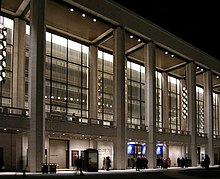New York City Opera: Difference between revisions
m Robot - change/delete category per CFD 2008 February 28 |
No edit summary |
||
| Line 33: | Line 33: | ||
==External links== |
==External links== |
||
*[http://www.nycopera.com New York City Opera website] |
*[http://www.nycopera.com New York City Opera website] |
||
*[http://theoperacritic.com/functions/wikipedia.php?type=company¶meter=nyc Reviews, articles, production photos and future schedules for New York City Opera from The Opera Critic] |
|||
*[http://www.nycopera.com/about/history/ History of New York City Opera] |
*[http://www.nycopera.com/about/history/ History of New York City Opera] |
||
*[http://www.soundfountain.org/rem/remhalasz.html Laszlo Halasz, the man who founded the NYC Opera Co.] |
*[http://www.soundfountain.org/rem/remhalasz.html Laszlo Halasz, the man who founded the NYC Opera Co.] |
||
Revision as of 22:34, 16 March 2008


The New York City Opera (NYCO) is based in Philip Johnson's New York State Theater at Lincoln Center.
The company was founded in 1944 with the aim of an opera company that would be financially accessible to a wide audience, innovative in its choice of repertory, and a home for American singers and composers.
The early years
In its early years, the NYCO's home base was the City Center on West 55th Street. In 1945, the company became the first major opera company to have an African American performer. This was in the production of Leoncavallo's Pagliacci with Todd Duncan's performance as Tonio. Lawrence Winters was another notable African American opera pioneer to sing with the company during this period. The first African American woman to sing with the company was Camilla Williams, soprano as Madama Butterfly in 1946. (Southern, 417) Winters and Williams later went on to sing the title roles in the most complete recording made up to that time of Gershwin's Porgy and Bess, for Columbia Masterworks Records in 1951.
The present day theater
On February 22, 1966, it inaugurated its new home at Lincoln Center with a production of Alberto Ginastera's Don Rodrigo with tenor Plácido Domingo. In 1966, the American soprano Beverly Sills made her major breakthrough as Cleopatra in Handel's Giulio Cesare (opposite Norman Treigle in the title role). While Sills went on to sing at opera houses throughout the world, she remained affiliated with the NYCO. Upon her retirement from the stage in 1979, she joined the company as its General Director, replacing conductor Julius Rudel, who had led the company since 1957. Sills retired as General Director in 1989 and was replaced by conductor Christopher Keene. Keene was succeeded in 1996 by Glimmerglass Opera's artistic director, Paul Kellogg.
Ongoing missions
Beverly Sills' success at NYCO is emblematic of NYCO's tradition of championing American singers. NYCO launched the careers of, among others, Sherrill Milnes, Carol Vaness, and Samuel Ramey. Internationally acclaimed American singers who still call NYCO home include Carl Tanner, David Daniels, Mark Delavan, Mary Dunleavy, Lauren Flanigan, Elizabeth Futral, and Amy Burton.
NYCO similarly champions the work of American composers; approximately one-third of its repertoire has traditionally been American Opera. NYCO's American repertoire ranges from established works (e.g., Douglas Moore's The Ballad of Baby Doe, Carlisle Floyd's Susannah and Leonard Bernstein's Candide) to new works (e.g., Rachel Portman's The Little Prince, Charles Wuorinen's Haroun and the Sea of Stories, and Mark Adamo's Little Women). NYCO's commitment to the future of American opera is demonstrated in its annual series, VOX: "Showcasing American Composers," in which operas-in-progress are showcased, giving composers a chance to hear their work performed by professional singers and orchestra. NYCO also produces non-traditional operatic repertoire such as works by Stephen Sondheim and Gilbert & Sullivan.
In 1983, the NYCO became the first American company to use supertitles. In recent years, the works of baroque masters such as Handel, Gluck, and Rameau have gained special prominence in its repertoire, sparking a renewal of interest in these long-neglected works.
The NYCO has extensive education and outreach programs, offering arts-in-education programs to 12,000 students in over seventy-five schools.
References
The Music of Black Americans: A History. Eileen Southern. W. W. Norton & Company; 3rd edition. ISBN 0-393-97141-4
Bibliography
- The New York City Opera, by Martin L Sokol, Macmillan Publishing Company, Inc, 1981. ISBN 0-02-612280-4
- New York City Opera Sings, by New York City Opera Guild, Richard Rosen Press, Inc, 1981. ISBN 0-8239-0544-6
